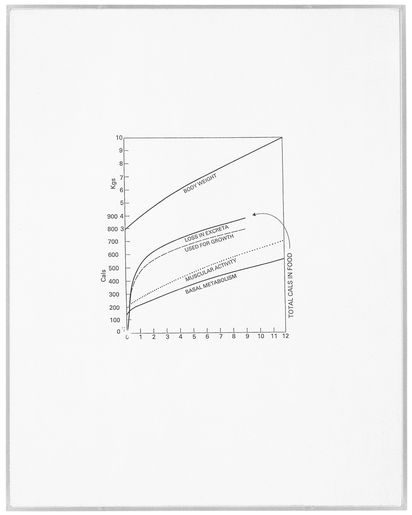Post-Partum Document I. Prototype

Mary Kelly
Post-Partum Document I. Prototype, 1974
Installation 10 parts Analysis of fecal stains and feeding charts, January 1 to 7, 1974, 7 diaper linings with fecal stains, plastic foil, text, ink on white cardboard, 3 black-and-white photocopies Framed in acrylic glass boxes 36.3 x 28.7 x 3.5 cm each
GF0001975.00.0-1998
Artwork text
Introduction In the Post-Partum Document, I am trying to show the reciprocity of the process of socialization in the first few years of life. It is not only the infant whose future personality is formed at this crucial moment, but also the mother whose “feminine psychology” is sealed by the sexual division of labor in childcare. The sexual division of labor is not a symmetrically structured system of women inside the home, men outside it, but rather an intricate, most often asymmetrical, delegation of tasks which aims to provide a structural imperative to heterosexuality. The most obvious example of this asymmetry is that of women engaged in social production or services who are still held socially responsible for maintaining labor power (i. e., males and children). But even more significant is the fact that the nuclear family form, under capitalism, requires more participation by fathers in housework and childcare while insisting on the social sexual division of labor. The last stronghold of the heterosexual imperative is therefore infant care. Certain tasks such as bathing, changing, and attending in the night remain almost exclusively female. Yet the specificity of this labor is essential to the reproduction of the relations of production, in so far as the monolithic mother-child relationship which it welds becomes the basic structure upon which adult socialization is founded. (MK) Documentation I Analyzed Fecal Stains and Feeding Charts: The feeding, changing process was recorded over a period of three months, January to March 1974. February, the infant’s sixth month, was presented in this document because it represented the interval of most rapid change. The total amount of solids taken on February 1 was 8 tsps and on February 28 it was 30 tsps. This corresponded to a gain in weight from 16 lbs 10 1/2 ozs to 18 lbs 2 1/2 ozs. In the document on exhibition, the infant’s daily nutritional intake was correlated with his stools, i. e., the stained liners, and these were analyzed according to the following key: 01 Constipated 02 Normal 03 Not Homogeneous 04 Loose 05 Diarrhoeal Growth in a given genus is proportional to the potential energy of the food consumed. An infant of seven months is only able to dispose of 13 percent of food energy for growth, the rest being lost in excreta. The introduction of solid foods is a dramatic event in so far as putrefactive organisms are consequently introduced into the essentially sterile intestinal tract of the newborn infant. Hence, the exact character of the faeces of a normal infant will depend upon: (1) the kind of food and the completeness of digestion; (2) the amount of putrefaction or fermentation; (3) the amount of bile secreted; (4) the amount of fat and water remaining unabsorbed. (Mary Kelly)










